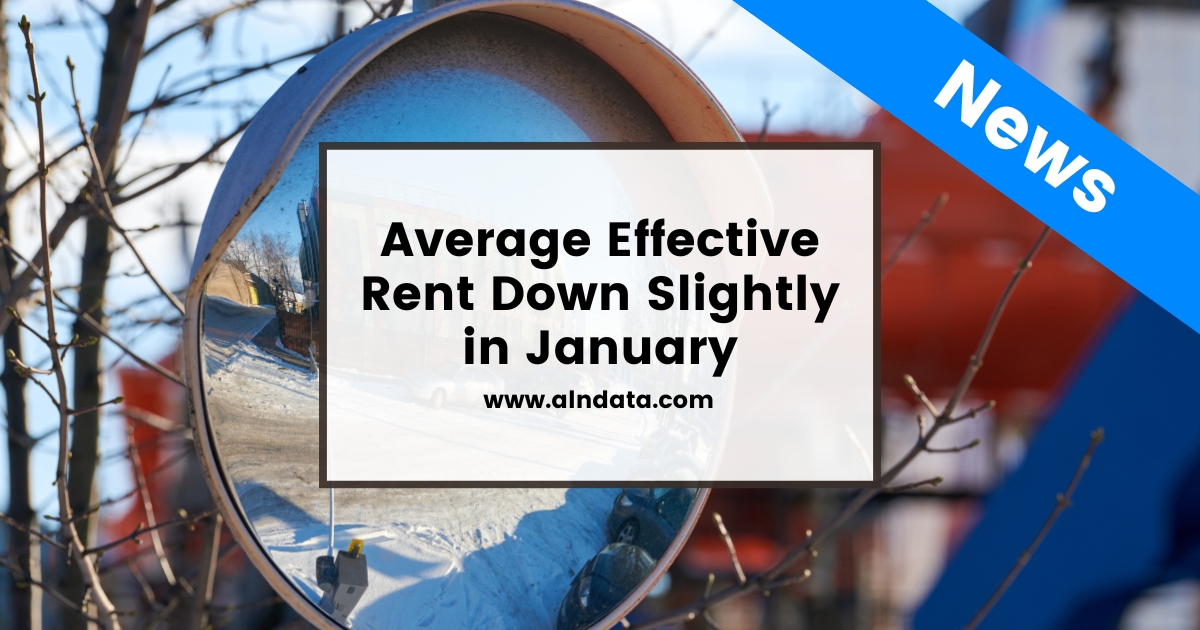Average Effective Rent Down Slightly in January
New supply that substantially exceeded net absorption in 2023 led to a consistent decline in national average occupancy. That decline took the remaining momentum out of rent growth. The year ended with four consecutive months of national average effective rent declines for new leases and those declines cut the annual growth total in half. With new supply not slowing, and the industry still squarely in the soft period of the calendar for apartment demand, a turnaround in rent performance has not yet occurred.
Five Straight Months of Decline
National average effective rent for new leases declined by 0.1% in January, making it the fifth straight month with a loss and adding to the longest streak of monthly declines in years. The positive news in January was that the peak of monthly losses appears to have occurred in the fourth quarter of 2023. January’s decrease was the smallest since September, the first month of the current five-month streak. Among other factors, this points to a likely return to positive territory in the next couple of months.
Another positive indication that negative rent growth may come to an end soon, at least for now, was that national net absorption in January returned to positive territory after a monthly loss of net leased units in November and December. Despite being well below the longer-term average for January, a return to positive demand bodes well for the upcoming spring period relative to rent performance. It should be noted that national net absorption in January was lower than in 2023 – which had been the low point from recent years.
Price Class Differences
Below the national monthly change trend, the price classes have displayed some differences. After monthly losses from September through November of last year, Class A average effective rent for new leases got back to flat in December before managing a 0.1% gain in January. Class B properties have represented the middle ground between Class A and overall national performance. The last four months of 2023 all featured monthly rent declines, but January average rent remained unchanged.

In our series Takeaways, ALN Apartment Data Senior Market Analyst, Jordan Brooks, shares more insight into the final thoughts on the April 2024 newsletter article…
There has even been a dichotomy between the two workforce housing price tiers. For the Class C group, recent rent performance has closely mirrored the nation. Negative monthly rent growth began in September and continued through January. However, the largest monthly declines occurred in October and November with the January decrease being only 0.1%.
Class D properties have experienced the most pronounced struggles on the rent growth front in recent months. The monthly declines began in September as with the other price tiers, but rather than monthly losses peaking in the fourth quarter and improving with the turn of the calendar, average effective rent has declined by 0.5% in each month from October through January. The rent struggles have followed predictably on the heels of sustained demand issues in this segment. In 23 of the last 24 months, Class D national net absorption has been negative.
Takeaways
There have been both positive and somewhat concerning indications in the recent monthly data for national rent growth and apartment demand. Both have ebbed since the end of last summer along usual seasonal patterns. For net absorption, it was positive to see a return to positive territory in January, but the monthly total was lower even than last year’s trough value. One month does not make a trend, but if 2024 is going to yield stronger demand than last year, January was not an ideal start.
Rent growth performance in January was arguably more encouraging. Despite a slight monthly decline, January was the third month in a row to see improvement over the previous period. If that trend holds, paired with a seasonal tailwind, national monthly rent growth will likely return to positive in February or March. The extent to which demand can improve to help offset the deluge of new units expected this year will play a major role in rent performance going forward.
Disclaimer: All content and information within this article is for informational purposes only. ALN Apartment Data makes no representation as to the accuracy or completeness of any information in this or any other article posted on this site or found by following any link on this site. The owner will not be held liable for any losses, injuries, or damages from the display or use of this information. All content and information in this article may be shared provided a link to the article or website is included in the shared content.

